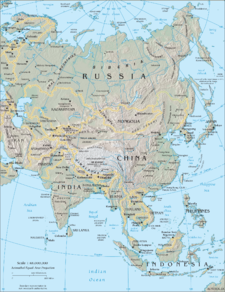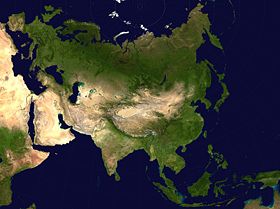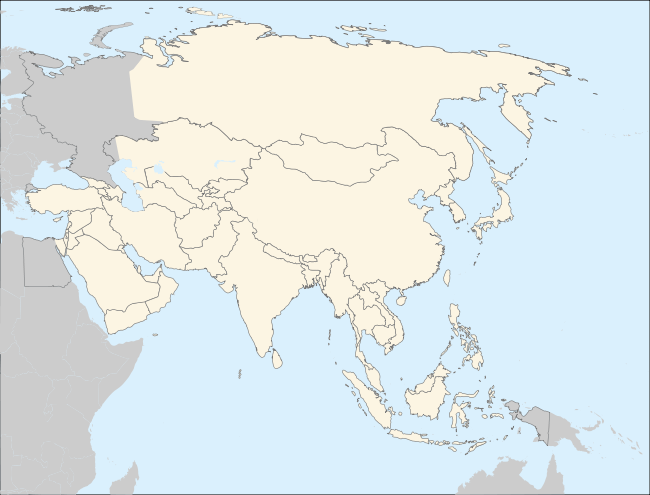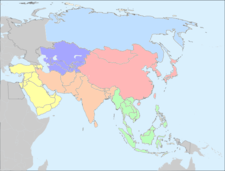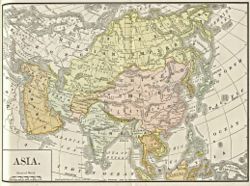Asia
2008/9 Schools Wikipedia Selection. Related subjects: Geography of Asia
Asia
| Area | 43,810,582 km² (16,915,360.3 sq mi) |
|---|---|
| Population | 3,879,000,000 (1st) |
| Density | 89.07/km² (230.7)/sq mi) |
| Demonym | Asian |
| No. of countries | 37 |
| Countries | |
| Dependencies | |
| Unrecognized Republics & Regions | |
| Languages |
Asian languages
|
| Time Zones |
+2 to +12
|
| Internet TLD | .asia, many others |
| Largest Cities |
Largest Cities in Asia
|
Asia is the world's largest and most populous continent. It covers 8.6% of the Earth's total surface area (or 29.4% of its land area) and, with over 4 billion people, it contains more than 60% of the world's current human population. Chiefly in the eastern and northern hemispheres, Asia is traditionally defined as part of the landmass of Eurasia—with the western portion of the latter occupied by Europe—lying east of the Suez Canal, east of the Ural Mountains, and south of the Caucasus Mountains and the Caspian and Black Seas. It is bounded on the east by the Pacific Ocean, on the south by the Indian Ocean, and on the north by the Arctic Ocean. Given its size and diversity, Asia—a toponym dating back to classical antiquity—is more a cultural concept incorporating a number of regions and peoples than a homogeneous physical entity (see Subregions of Asia, Asian people).
Etymology
The word Asia originated from the Ancient Greek word "Ασία", first attributed to Herodotus (about 440 BC) in reference to Anatolia or, for the purposes of describing the Persian Wars, to the Persian Empire, in contrast to Greece and Egypt. Herodotus comments that he is puzzled as to why three women's names are used to describe one enormous and substantial land mass ( Europa, Asia, and Libya, referring to Africa), stating that most Greeks assumed that Asia was named after the wife of Prometheus but that the Lydians say it was named after Asias, son of Cotys who passed the name on to a tribe in Sardis.
Even before Herodotus, Homer knew of a Trojan ally named Asios and elsewhere he describes a marsh as ασιος (Iliad 2, 461). The Greek language term may be derived from Assuwa, a 14th century BC confederation of states in Western Anatolia. Hittite assu-—"good" is probably an element in that name.
Alternatively, the etymology of the term may be from the Akkadian word (w)aṣû(m), which means "to go outside" or "to ascend", referring to the direction of the sun at sunrise in the Middle East, and also likely connected with the Phoenician word asa meaning east. This may be contrasted to a similar etymology proposed for Europe, as being from Akkadian erēbu(m) "to enter" or "set" (of the sun). However, this etymology is considered doubtful, because it does not explain how the term "Asia" first came to be associated with Anatolia, which is west of the Semitic-speaking areas, unless they refer to the viewpoint of a Phoenician sailor sailing through the straits between the Mediterranean Sea and the Black Sea.
It is interesting to note, in Icelandic Saga, ancient Teutons separated Asia from Europe by the river Tanakvisl (or Vanakvisl), which flows into the Black Sea. Eastward across the River (in Asia), so legend tells, was a land known as Asaheim or Asaland, where dwelt Odin, chief god, in his citadel named Asgard. However, Aesir and all its forms are related to Sanskrit asura and Avestan ahura, the local reflexes of the name of a class of divine beings.
Definition and boundaries
Physical geography
Medieval Europeans considered Asia as a continent – a distinct landmass. The European concept of the three continents in the Old World goes back to Classical Antiquity, but during the Middle Ages was notably due to Isidore of Sevilla (see T and O map). The demarcation between Asia and Africa (to the southwest) is the Isthmus of Suez and the Red Sea. The boundary between Asia and Europe is conventionally considered to run through the Dardanelles, the Sea of Marmara, the Bosporus, the Black Sea, the Caucasus Mountains, the Caspian Sea, the Ural River to its source, and the Ural Mountains to the Kara Sea near Kara, Russia. While this interpretation of tripartite continents (i.e., of Asia, Europe, and Africa) remains common in modernity, discovery of the extent of Africa and Asia have made this definition somewhat anachronistic. This is especially true in the case of Asia, which would have several regions that would be considered distinct landmasses if these criteria were used (for example, Southern Asia and Eastern Asia).
In the far northeast of Asia, Siberia is separated from North America by the Bering Strait. Asia is bounded on the south by the Indian Ocean (specifically, from west to east, the Gulf of Aden, Arabian Sea, and Bay of Bengal); on the east by the waters of the Pacific Ocean (including, counterclockwise, the South China Sea, East China Sea, Yellow Sea, Sea of Japan, Sea of Okhotsk, and Bering Sea); and on the north by the Arctic Ocean. Australia (or Oceania) is to the southeast.
Some geographers do not consider Asia and Europe to be separate continents, as there is no logical physical separation between them. Geographically, Asia is the major eastern constituent of the continent of Eurasia – with Europe being a northwestern peninsula of the landmass – or of Afro-Eurasia: geologically, Asia, Europe, and Africa comprise a single continuous landmass (save the Suez Canal) and share a common continental shelf. Almost all of Europe and most of Asia sit atop the Eurasian Plate, adjoined on the south by the Arabian and Indian Plates, and with the easternmost part of Siberia (east of the Cherskiy Range) on the North American Plate.
In geography, there are two schools of thought. One school follows historical convention and treats Europe and Asia as different continents, categorizing subregions within them for more detailed analysis. The other school equates the word "continent" with a geographical region when referring to Europe, and use the term "region" to describe Asia in terms of physiography. Since, in linguistic terms, "continent" implies a distinct landmass, it is becoming increasingly common to substitute the term "region" for "continent" to avoid the problem of disambiguation altogether.
Given the scope and diversity of the landmass, it is sometimes not even clear exactly what "Asia" consists of. Some definitions exclude Turkey, the Middle East, Central Asia, and Russia while only considering the Far East, Southeast Asia and the Indian subcontinent to compose Asia, especially in the United States after World War II. The term is sometimes used more strictly in reference to the Asia-Pacific region, which does not include the Middle East or Russia, but does include islands in the Pacific Ocean—a number of which may also be considered part of Australasia or Oceania, although Pacific Islanders are commonly not considered Asian.
Political geography
"Asian" as a demonym
The demonym " Asian" is often used colloquially to refer to people from a subregion of Asia instead of for anyone from Asia. Thus, in British English, "Asian" can mean South Asian, but may also refer to other Asian groups. In the United States, " Asian American" can mean East Asian Americans, due to the historical and cultural influences of China and Japan on the U.S. up to the 1960s and in preference to the terms " Oriental" and "Asiatic". However, the term is increasingly taken to include Southeast Asian Americans and South Asian Americans, due to the increasing numbers of them.
Territories and regions
| Name of region and territory, with flag |
Area (km²) |
Population ( 1 July 2008 est.) |
Population density (per km²) |
Capital |
|---|---|---|---|---|
| Central Asia: | ||||
| 2,346,927 | 15,340,533 | 5.7 | Astana | |
| 198,500 | 5,356,869 | 24.3 | Bishkek | |
| 143,100 | 7,211,884 | 47.0 | Dushanbe | |
| 488,100 | 5,179,573 | 9.6 | Ashgabat | |
| 447,400 | 28,268,441 | 57.1 | Tashkent | |
| Eastern Asia: | ||||
| 9,584,492 | 1,322,044,605 | 134.0 | Beijing | |
| 1,092 | 7,903,334 | 6,688.0 | — | |
| 377,835 | 127,288,628 | 336.1 | Tokyo | |
| 25 | 460,823 | 18,473.3 | — | |
| 1,565,000 | 2,996,082 | 1.7 | Ulaanbaatar | |
| 120,540 | 23,479,095 | 184.4 | Pyongyang | |
| 98,480 | 49,232,844 | 490.7 | Seoul | |
| 35,980 | 22,920,946 | 626.7 | Taipei | |
| Northern Africa: | ||||
| 980,869 | 81,713,517 | 21.7 | Cairo | |
| Northern Asia: | ||||
| 13,115,200 | 140,702,092 | 3.0 | Moscow | |
| Southeastern Asia: | ||||
| 5,770 | 381,371 | 60.8 | Bandar Seri Begawan | |
| 181,040 | 14,241,640 | 70.6 | Phnom Penh | |
| 15,007 | 1,108,777 | 63.5 | Dili | |
| 1,419,588 | 237,512,355 | 159.9 | Jakarta | |
| 236,800 | 6,677,534 | 24.4 | Vientiane | |
| 329,750 | 25,274,135 | 68.7 | Kuala Lumpur | |
| 678,500 | 47,758,224 | 62.3 | Naypyidaw | |
| 300,000 | 92,681,453 | 281.8 | Manila | |
| 704 | 4,608,167 | 6,369.0 | Singapore | |
| 514,000 | 65,493,298 | 121.3 | Bangkok | |
| 331,690 | 86,116,559 | 246.1 | Hanoi | |
| Southern Asia: | ||||
| 647,500 | 32,738,775 | 42.9 | Kabul | |
| 144,000 | 153,546,901 | 926.2 | Dhaka | |
| 47,000 | 682,321 | 14.3 | Thimphu | |
| 3,167,590 | 1,147,995,226 | 318.2 | New Delhi | |
| 1,648,195 | 65,875,223 | 42 | Tehran | |
| 300 | 379,174 | 1,067.2 | Malé | |
| 140,800 | 29,519,114 | 183.8 | Kathmandu | |
| 803,940 | 167,762,049 | 183.7 | Islamabad | |
| 65,610 | 21,128,773 | 298.4 | Colombo | |
| Western Asia: | ||||
| 29,800 | 2,968,586 | 111.7 | Yerevan | |
| 46,870 | 3,845,127 | 82.0 | Baku | |
| 665 | 718,306 | 987.1 | Manama | |
| 9,250 | 792,604 | 83.9 | Nicosia | |
| 363 | 1,537,269 | 3,315.7 | Gaza | |
| 20,460 | 4,630,841 | 99.3 | Tbilisi | |
| 437,072 | 28,221,181 | 54.9 | Baghdad | |
| 20,770 | 7,112,359 | 290.3 | Jerusalem | |
| 92,300 | 6,198,677 | 57.5 | Amman | |
| 17,820 | 2,596,561 | 118.5 | Kuwait City | |
| 10,452 | 3,971,941 | 353.6 | Beirut | |
| 212,460 | 3,311,640 | 12.8 | Muscat | |
| 11,437 | 928,635 | 69.4 | Doha | |
| 1,960,582 | 23,513,330 | 12.0 | Riyadh | |
| 185,180 | 19,747,586 | 92.6 | Damascus | |
| 756,768 | 71,892,807 | 76.5 | Ankara | |
| 82,880 | 4,621,399 | 29.5 | Abu Dhabi | |
| 5,860 | 2,611,904 | 393.1 | — | |
| 527,970 | 23,013,376 | 35.4 | Sanaá | |
| Total | 43,810,582 | 4,050,404,193 | 89.07 | |
See Also: List of Asian countries by population
Country name changes
The names of quite a few Asian countries have changed during the last century.
| Previous Name | Year | Current Name |
|---|---|---|
| East Pakistan | 1971 | Bangladesh, People's Republic of |
| Kampuchea, Democratic | 1975 | Cambodia, Kingdom of |
| Portuguese Timor | 1975 | East Timor, Democratic Republic of |
| Dutch East Indies | 1949 | Indonesia, Republic of |
| Persian Empire | 1935 | Iran, Republic of |
| Transjordan | 1946 | Jordan, Kingdom of |
| Kirghizia (USSR) | 1991 | Kyrgyzstan, Republic |
| Malaya, Sabah, Sarawak and Singapore | 1963 | Malaysia |
| Burma | 1989 | Myanmar, Union of |
| Muscat | 1971 | Oman, Sultanate of |
| West Pakistan | 1971 | Pakistan, Republic of |
| Hejaz- Nejd, The Kingdom of | 1932 | Saudi Arabia, Kingdom of |
| Aden | 1970 | South Yemen, People's Republic of |
| Ceylon | 1972 | Sri Lanka, Democratic Socialist Republic of |
| Formosa, Republic | 1945 | Taiwan |
| Tajik S.S.R | 1991 | Tajikistan, Republic of |
| Siam | 1939 | Thailand, Kingdom of |
| Ottoman Empire | 1923 | Turkey, Republic of |
| Turkmen SSR (USSR) | 1991 | Turkmenistan |
| Trucial Oman & Trucial States | 1971 | United Arab Emirates |
| French Indo-China | 1949 | Vietnam, Socialist Republic of |
| Yemen, People's Democratic & Southern Yemen | 1970 | Yemen, Republic of |
Economy
| Population: | 3,958,768,100 (2006 Estimate) |
| GDP ( PPP): | US$18.077 trillion |
| GDP ( Currency): | $8.782 trillion |
| GDP/capita ( PPP): | $4,518 |
| GDP/capita ( Currency): | $2,143 |
| Millionaires: | 2.0 million (0.05%) |
| Most numbers are from the UNDP from 2002, some numbers exclude certain countries for lack of information. | |
| See also: Economy of the world - Economy of Africa - Economy of Asia - Economy of Europe - Economy of North America - Economy of Oceania - Economy of South America | |
Asia has the third largest nominal GDP of all continents, after North America and Europe, but the largest when measured in PPP. As of 2007, the largest national economy within Asia, in terms of gross domestic product (GDP), is that of China followed by that of India, Japan and South Korea. However, in nominal (exchange value) terms, they rank as follows: Japan, China, India, South Korea, Saudi Arabia, Taiwan, Indonesia. Since the 1960s, South Korea had maintained the highest economic growth rate in Asia, nicknamed as an Asian tiger, becoming a newly industrialized country in the 1980s and a developed country by the 21st century. In the late 1990s and early 2000s, the economies of the PRC and India have been growing rapidly, both with an average annual growth rate of more than 8%. Other recent very high growth nations in Asia include the Philippines, Pakistan, Vietnam, Mongolia, Uzbekistan and mineral-rich nations such as Kazakhstan, Turkmenistan, Iran, Brunei, United Arab Emirates, Qatar, Kuwait, Saudi Arabia, Bahrain, and Oman.
Historically, Japan has had the largest economy in Asia and second-largest of any single nation in the world, after surpassing the Soviet Union (measured in net material product) in 1986 and Germany in 1968. (NB: A number of supernational economies are larger, such as the EU, NAFTA or APEC). In the late 1980s and early 1990s, Japan's GDP was almost as large (current exchange rate method) as that of the rest of Asia combined. In 1995, Japan's economy nearly equalled that of the USA to tie as the largest economy in the world for a day, after the Japanese currency reached a record high of 79 yen. Economic growth in Asia since World War II to the 1990s had been concentrated in the four countries of South Korea, Taiwan, Hong Kong and Singapore located in the pacific rim, known as the Asian tigers, which have now all received developed country status, having the highest GDP per capita in Asia.
It is forecast that the People's Republic of China will surpass Japan to have the largest nominal and PPP-adjusted GDP in Asia within a decade. India is also forecast to overtake Japan in terms of Nominal GDP by 2020. In terms of GDP per capita, both nominal and PPP-adjusted, South Korea will become the second wealthiest country in Asia by 2025, overtaking Germany, UK and France and 25 years later, surpass Japan, becoming the wealthiest country in Asia.
Trade blocs
- Asia-Pacific Economic Cooperation
- Asia-Europe Economic Meeting
- Association of Southeast Asian Nations
- Gulf Cooperation Council
- Closer Economic Partnership Arrangement
- Commonwealth of Independent States
- South Asian Association for Regional Cooperation
Manufacturing
Manufacturing in Asia has traditionally been strongest in East and Southeast Asia, particularly in mainland China, Taiwan, Japan, South Korea and Singapore. Japan and South Korea continue to dominate in the area of multinational corporations, but increasingly mainland China, Taiwan, and India are making significant inroads. Many companies from Europe, North America, South Korea and Japan have operations in Asia's developing countries to take advantage of its abundant supply of cheap labour and relatively developed infrastructure.
Financial and other services
Asia has four main financial centres: India, Hong Kong, Singapore, and Tokyo. Call centres and business process outsourcing (BPOs) are becoming major employers in India and the Philippines due to the availability of a large pool of highly-skilled, English-speaking workers. The increased use of outsourcing has assisted the rise of India and the People's Republic of China as financial centres. Due to its large and extremely competitive information technology industry, India has become a major hub for outsourcing.
Early history
The history of Asia can be seen as the distinct histories of several peripheral coastal regions: East Asia, South Asia, and the Middle East, linked by the interior mass of the Central Asian steppes.
The coastal periphery was home to some of the world's earliest known civilizations, each of them developing around fertile river valleys. The civilizations in Mesopotamia, the Indus Valley, and the Huanghe shared many similarities. These civilizations may well have exchanged technologies and ideas such as mathematics and the wheel. Other innovations, such as writing, seem to have been developed individually in each area. Cities, states, and empires developed in these lowlands.
The central steppe region had long been inhabited by horse-mounted nomads who could reach all areas of Asia from the steppes. The earliest postulated expansion out of the steppe is that of the Indo-Europeans, who spread their languages into the Middle East, South Asia, and the borders of China, where the Tocharians resided. The northernmost part of Asia, including much of Siberia, was largely inaccessible to the steppe nomads, owing to the dense forests, climate, and tundra. These areas remained very sparsely populated.
The centre and the peripheries were mostly kept separated by mountains and deserts. The Caucasus and Himalaya mountains and the Karakum and Gobi deserts formed barriers that the steppe horsemen could cross only with difficulty. While the urban city dwellers were more advanced technologically and socially, in many cases they could do little in a military aspect to defend against the mounted hordes of the steppe. However, the lowlands did not have enough open grasslands to support a large horsebound force; for this and other reasons, the nomads who conquered states in China, India, and the Middle East often found themselves adapting to the local, more affluent societies.
Languages and literature
Asia is home to several language families and many language isolates. Most Asian countries have more than one language that is natively spoken. For instance, according to Ethnologue, more than 600 languages are spoken in Indonesia, more than 415 languages spoken in India, and more than 100 are spoken in the Philippines. The People's Republic of China has many languages and dialects in different provinces.
Nobel prizes
The polymath Rabindranath Tagore, a Bengali poet, dramatist, and writer from Santiniketan, now in West Bengal, India, became in 1913 the first Asian Nobel laureate. He won his Nobel Prize in Literature for notable impact his prose works and poetic thought had on English, French, and other national literatures of Europe and the Americas. He is also the writer of the national anthems of Bangladesh and India.
Tagore is said to have named another Bengali Indian Nobel prize winner, the 1998 laureate in Economics, Amartya Sen. Sen's work has centered around global issues including famine, welfare, and third-world development. Amartya Sen was Master of Trinity College, Cambridge University, UK, from 1998-2004, becoming the first Asian to head an 'Oxbridge' College.
Other Asian writers who won Nobel Prizes include Yasunari Kawabata (Japan, 1966), Kenzaburo Oe (Japan, 1994), Gao Xingjian (People's Republic of China, 2000) and Orhan Pamuk (Turkey, 2006).
Also, Mother Teresa of India and Shirin Ebadi of Iran were awarded the Nobel Peace Prize for their significant and pioneering efforts for democracy and human rights, especially for the rights of women and children. Ebadi is the first Iranian and the first Muslim woman to receive the prize. Another Nobel Peace Prize winner is Aung San Suu Kyi from Myanmar for her peaceful and non-violent struggle under a military dictatorship in Myanmar. She is a nonviolent pro-democracy activist and leader of the National League for Democracy in Myanmar (Burma), and a noted prisoner of conscience. She is a Buddhist and was awarded the Nobel Peace Prize in 1991.
Other Asian Nobel Prize winners include Subrahmanyan Chandrasekhar, Venkata Raman, Abdus Salam, Shmuel Yosef Agnon, Robert Aumann, Menachem Begin, Aaron Ciechanover, Avram Hershko, Daniel Kahneman, Shimon Peres, Yitzhak Rabin, Yaser Arafat, and Kim Daejung, all of whom are Israelis except Subrahmanyan Chandrasekhar and Venkata Raman (who are both Indian), Abdus Salam (who is Pakistani), Yaser Arafat (who is Palestinian), and Kim Daejung (who is from South Korea).
In 2006 Dr. Mohammad Yunus from Bangladesh and the Grameen Bank he established to lend money to poor people especially women in Bangladesh was awarded the Nobel Peace Prize. Dr. Yunus received his Ph.D. in economics from Vanderbilt University, United States. He is internationally known for the concept of micro credit which allows poor and destitutes with little or no collateral to borrow money. The borrowers typically pay back money within specified period of time and the incidence of default is very low.
Beliefs
Mythology
Asian mythology is diverse. The story is first found in Mesopotamian mythology, in the Epic of Gilgamesh. Hindu mythology tells about an avatar of God Vishnu in the form of a fish who warned Manu of a terrible flood. In ancient Chinese mythology, Shan Hai Jing, the Chinese ruler Da Yu, had to spend 10 years to control a deluge which swept out most of ancient China and was aided by the goddess Nüwa who literally fixed the broken sky through which huge rains were pouring. The story is also found in the Bible and Qur'an.
Religions
Asian philosophical traditions originated in India and China and cover a large spectrum of philosophical thoughts and writings. Indian philosophy includes Hindu philosophy and Buddhist philosophy. They include elements of nonmaterial pursuits, whereas another school of thought from India, Cārvāka, preached the enjoyment of material world. Also Methidistism and protestism is popular among Koreans
Abrahamic
Abrahamic religions of Judaism, Christianity and Islam originated in West Asia. The world's largest Muslim community (within the bounds of one nation) is in Indonesia. South Asia (mainly Pakistan, India and Bangladesh) holds 30% of Muslims. There are also significant Muslim populations in China, Iran, Malaysia, the Philippines, Russia and most of West Asia and Central Asia. In the Philippines and East Timor, Roman Catholicism is the predominant religion; it was introduced by the Spaniards and the Portuguese, respectively. In Armenia, Eastern Orthodoxy is the predominant religion. Various Christian denominations have adherents in portions of the Middle East, as well as China and India. Judaism, one of the smaller yet oldest of the Abrahamic faiths, is practiced primarily in Israel (which has either the largest or second largest Jewish population in the world), though small communities exist in other countries, such as the Bene Israel in India.
Indian
The Indian religions of Sikhism, Hinduism, Buddhism and Jainism originated in South Asia. In East Asia, particularly in China and Japan, Confucianism, Taoism and Zen Buddhism took shape. During the 20th century, in the two most populous countries of Asia, two dramatically different political philosophies took shape. Gandhi gave a new meaning to Ahinsa, and redefined the concepts of nonviolence and nonresistance.
Other
Other religions of Asia include the Zoroastrianism, Shamanism practiced in Iran and Siberia respectively, Shintoism practised in Japan (usually with Buddhism) and Animism practiced in the eastern parts of the Indian subcontinent and in Southeast Asia.

